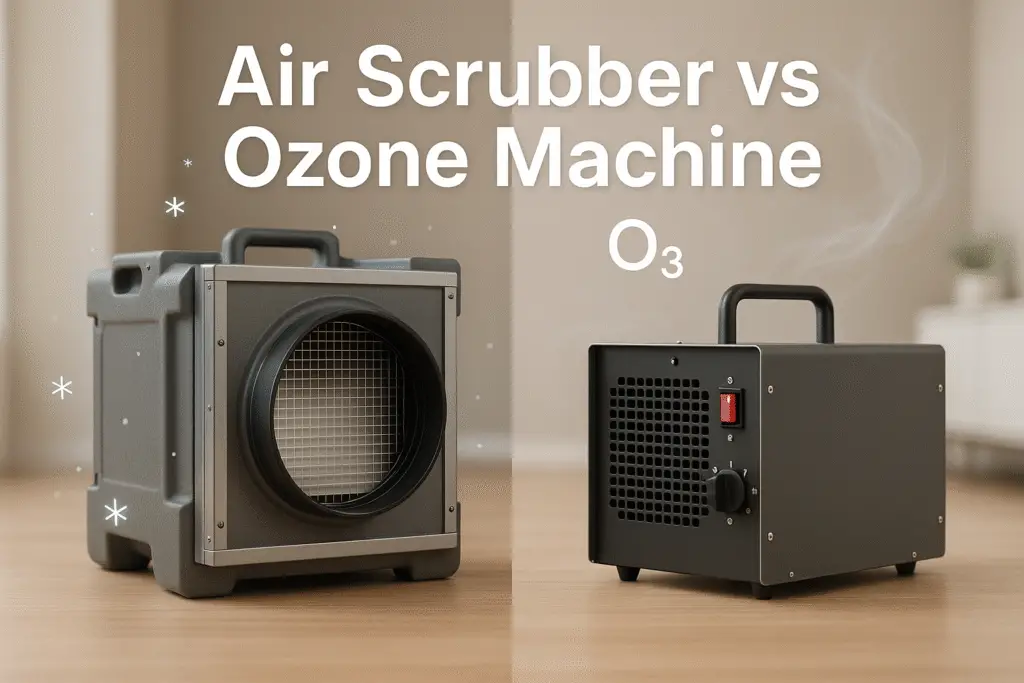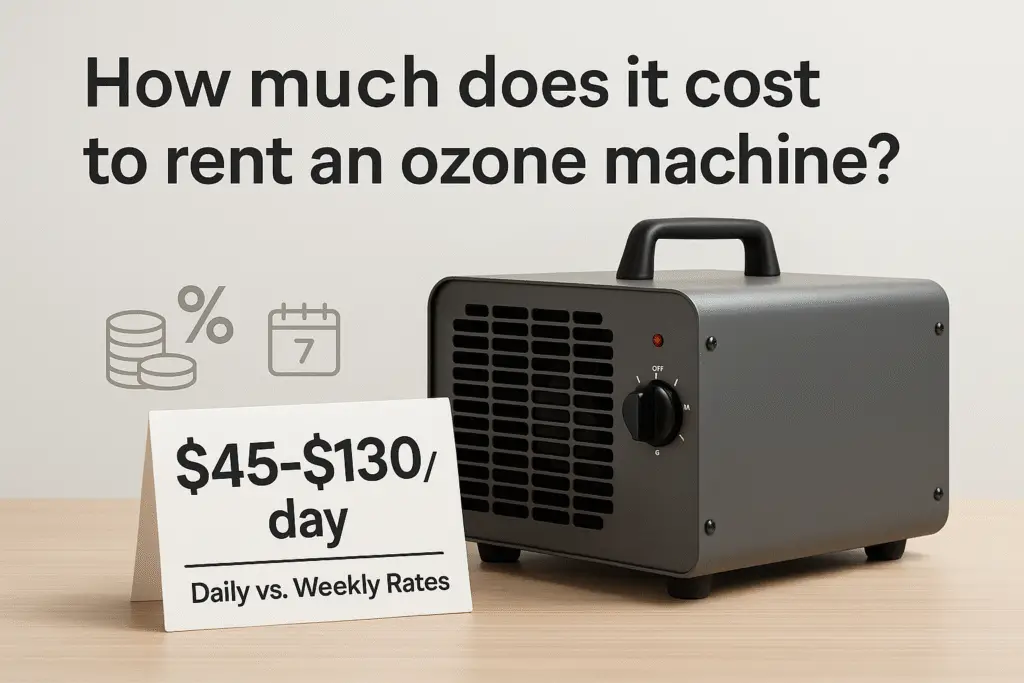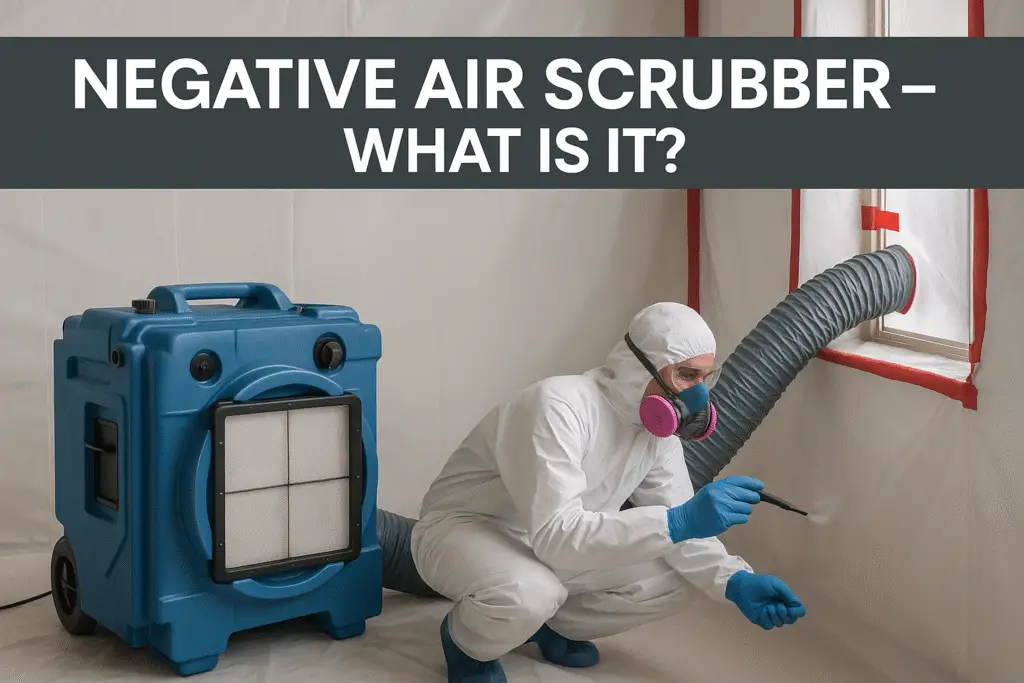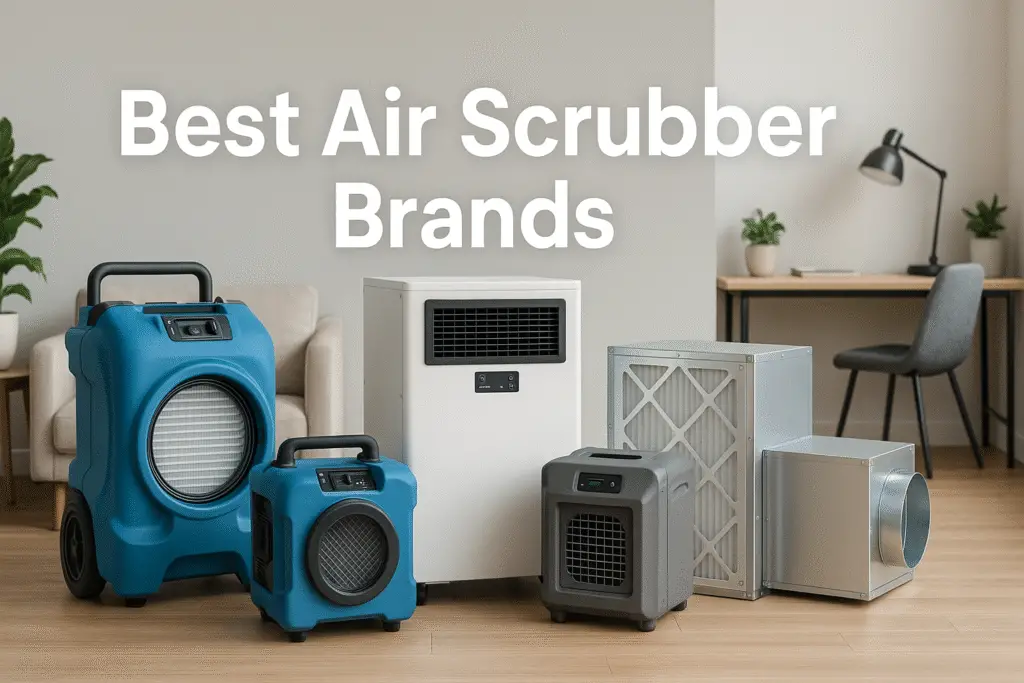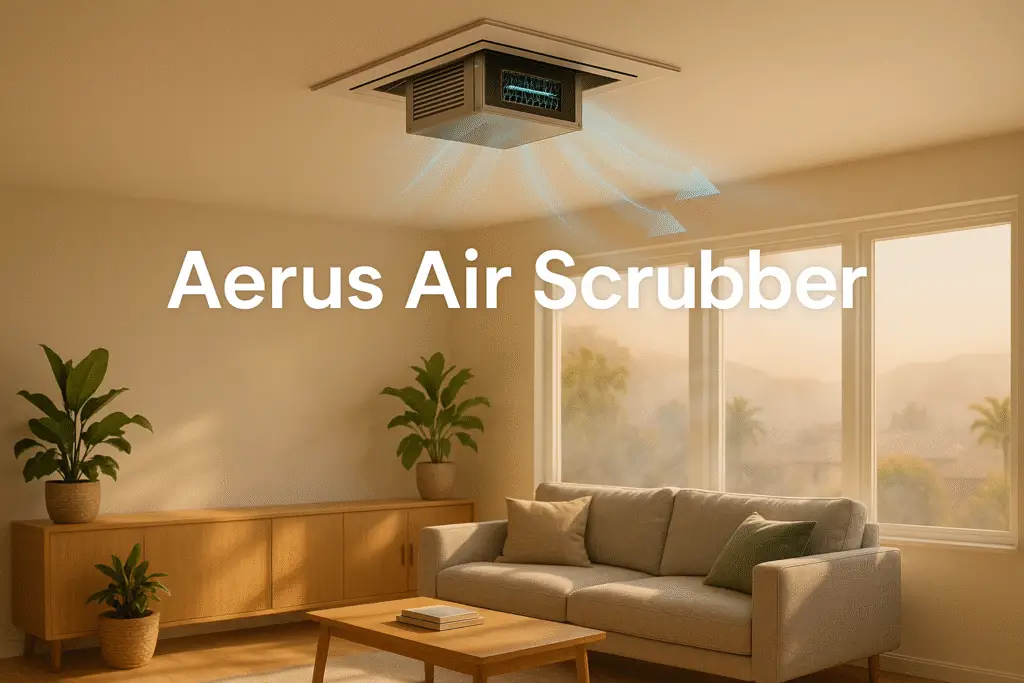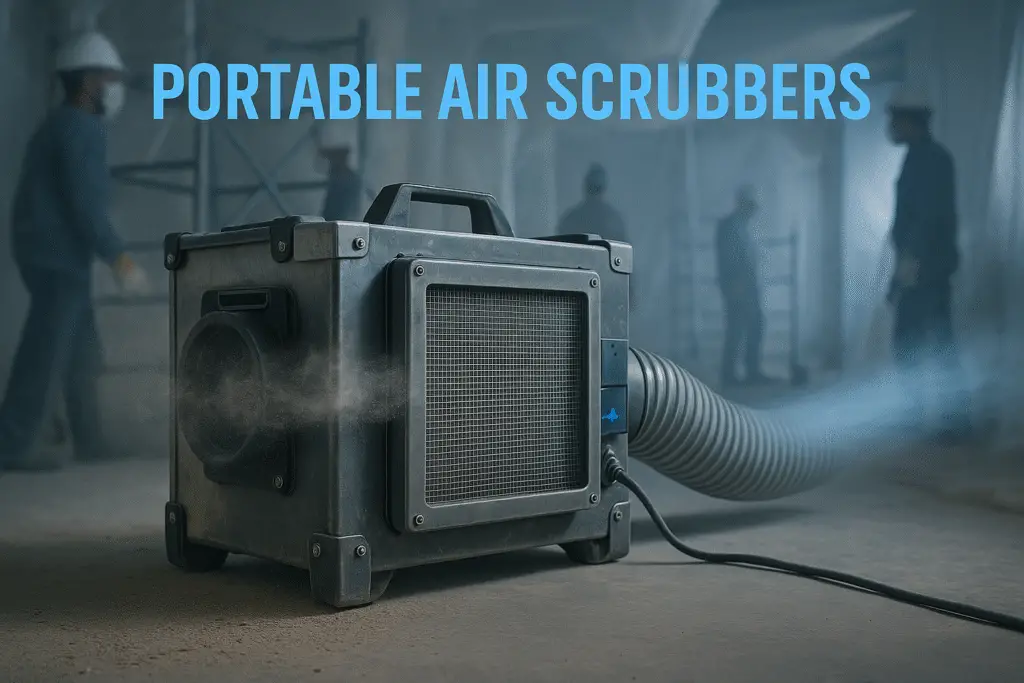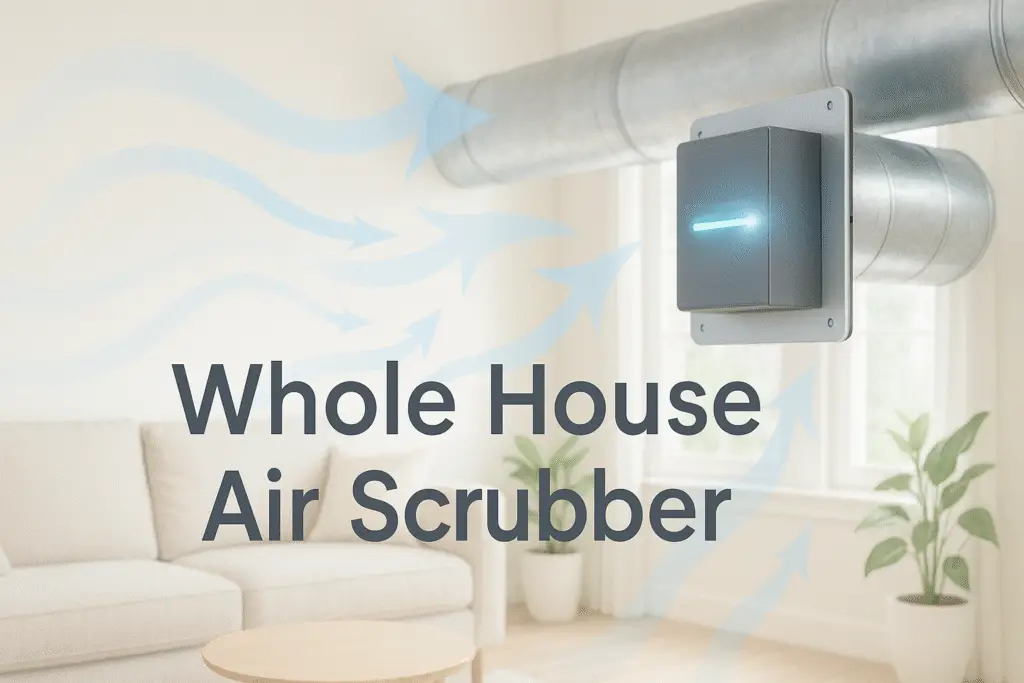Air scrubbers and ozone machines are distinct air treatment technologies that operate using fundamentally different principles. Air scrubbers filter and purify air by drawing it through a series of filters, while ozone machines release ozone gas that oxidizes contaminants. These differences significantly impact their safety, application, and effectiveness for various air quality issues.
This comprehensive guide examines the critical differences between these technologies to help you make an informed decision based on your specific air quality needs. Whether you’re dealing with odors, mold remediation, or general air purification, understanding these differences is essential for choosing the right solution.
What Are Air Scrubbers and Ozone Machines?
Air scrubbers and ozone machines are air treatment technologies designed to improve indoor air quality, but they function through entirely different mechanisms and have distinct safety profiles, applications, and limitations.
Air Scrubber Technology: How They Work and Core Components
An air scrubber is a filtration-based air purification system that draws air through a series of filters to remove particulates, chemicals, and contaminants. Unlike simple air purifiers, professional-grade air scrubbers often incorporate additional purification technologies beyond basic filtration.
| Photo | Popular Air Purifiers | Price |
|---|---|---|

|
Air Purifiers for Home Large Room up to 1500ft², Tailulu H13 True HEPA Air Purifier for Pets Dust Odor Smoke, Air Purifier for Bedroom with 15dB Quiet Sleep Mode for Bedroom Office Living Room | Check Price On Amazon |
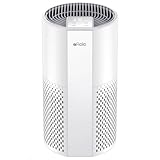
|
Afloia Air Purifier for Home, 4-in-1 Washable Filter for Allergies, Covers Up to 1076 ft², Quiet Operation, Auto Shut-Off & Night Light, Removes Pet Dander, Pollen, Dust, Mold, and Smoke, White,Pluto | Check Price On Amazon |

|
Nuwave OxyPure ZERO Air Purifier with Washable and Reusable Bio Guard Tech Air Filter, Large Room Up to 2002 Ft², Air Quality Monitor, 0.1 Microns, 100% Capture Irritants like Smoke, Dust, Pollen | Check Price On Amazon |

|
Air Purifiers for Home Large Room Up to 1,996 Ft², EOEBOT Air Purifier for Home Pets with Washable Filter, Quiet Sleep Mode, Air Quality Monitor, Air Purifier for Bedroom, Pet Hair, Dust, Smoke, White | Check Price On Amazon |

|
Afloia 2 IN 1 Air Purifier with Humidifier Combo, 3-Stage Filters for Home Allergies Pets Hair Smoker Odors, Evaporative Humidifier, Auto Shut Off, Quiet Air Cleaner with Seven Color Light,White | Check Price On Amazon |
Key components of air scrubbers include:
- Pre-filter: Captures larger particles (dust, hair, debris)
- HEPA filter: Removes 99.97% of particles as small as 0.3 microns
- Activated carbon filter: Absorbs odors, gases, and VOCs
- Fan system: Circulates air through the unit
- Optional technologies: UV-C light, PCO (photocatalytic oxidation), or ionization to enhance purification
According to the American Society of Heating, Refrigerating and Air-Conditioning Engineers (ASHRAE), professional air scrubbers typically process between 500-2000 cubic feet of air per minute, making them significantly more powerful than residential air purifiers.
Ozone Machine Technology: Generation Methods and Operational Principles
An ozone machine (also called an ozone generator) is a device that intentionally produces ozone (O₃) gas to oxidize and eliminate contaminants in the air and on surfaces. Ozone is a highly reactive molecule that breaks down odors, kills microorganisms, and neutralizes many chemical compounds.
Ozone generators produce ozone through one of three primary methods:
- Corona discharge: Passes air through an electrical field, converting O₂ to O₃ (most common method)
- Ultraviolet radiation: Uses UV light at specific wavelengths to convert oxygen to ozone
- Cold plasma: Creates ozone through electrical discharge in a plasma field
The Environmental Protection Agency (EPA) notes that ozone generators can produce concentrations between 3-10 parts per million (ppm), far exceeding the EPA’s safe exposure limit of 0.05 ppm.
Key Terminology for Understanding Air Treatment Technologies
- HEPA (High-Efficiency Particulate Air): Filtration standard that removes 99.97% of particles ≥0.3 microns
- MERV (Minimum Efficiency Reporting Value): Rating system (1-20) for filter efficiency
- CFM (Cubic Feet per Minute): Measure of air volume a device can process
- Oxidation: Chemical reaction where molecules lose electrons, breaking down contaminants
- PPM (Parts Per Million): Concentration measurement used for ozone levels
- VOCs (Volatile Organic Compounds): Harmful gases emitted from many products and materials
11 Essential Differences Between Air Scrubbers and Ozone Machines
1. Operational Mechanisms: Active vs. Passive Air Treatment
Air scrubbers and ozone machines operate through fundamentally different mechanisms. Air scrubbers use a passive treatment approach, drawing air through filters to remove contaminants. Ozone machines employ active treatment, releasing a reactive gas that seeks out and chemically alters contaminants.
According to research from the Journal of Air & Waste Management Association, this difference significantly impacts application scenarios. Air scrubbers only treat air that passes through the unit, while ozone penetrates throughout a space and into porous materials, reaching areas filtration cannot.
| Air Scrubbers | Ozone Machines |
|---|---|
| Removes contaminants from air passing through filters | Releases ozone gas that chemically reacts with contaminants |
| Only treats air that circulates through the unit | Treats entire space including surfaces and porous materials |
| Continuous operation possible with people present | Batch treatment requiring evacuation of people and pets |
2. Safety Profiles: Human and Pet Considerations
Air scrubbers can safely operate in occupied spaces continuously. Ozone machines must only be used in unoccupied spaces due to ozone’s potential health hazards. The EPA classifies ozone as a lung irritant that can cause respiratory issues, throat irritation, chest pain, and worsen asthma and other respiratory conditions.
According to the EPA, even low ozone concentrations (0.08 ppm) can cause health problems with prolonged exposure. Most ozone generators produce levels significantly higher than this safety threshold.
| Safety Consideration | Air Scrubbers | Ozone Machines |
|---|---|---|
| Safe for occupied spaces | Yes – can run continuously with people present | No – space must be completely evacuated |
| Safe for pets | Yes | No – can harm animals, including fish, birds, and plants |
| Respiratory risks | Minimal to none when properly maintained | Significant – can cause respiratory irritation and damage |
3. Contaminant Targeting: What Each Technology Effectively Removes
Air scrubbers and ozone machines target different types of contaminants with varying effectiveness. Air scrubbers excel at removing particulate matter, while ozone machines are particularly effective against odors and microorganisms.
| Contaminant Type | Air Scrubber Effectiveness | Ozone Machine Effectiveness |
|---|---|---|
| Dust, pollen, dander | Excellent (95-99.97% removal) | Poor (no direct removal) |
| Mold spores | Very good (captures airborne spores) | Moderate (kills surface mold if concentrated enough) |
| Bacteria and viruses | Good with HEPA + UV (captures and kills) | Very good (oxidizes and kills microorganisms) |
| Odors (smoke, pet, etc.) | Moderate (with carbon filtration) | Excellent (chemically breaks down odor molecules) |
| VOCs | Good (with proper carbon filtration) | Variable (may reduce some VOCs but create others) |
According to a study in the International Journal of Environmental Research and Public Health, ozone’s effectiveness against microorganisms requires concentrations significantly higher than safe exposure limits, highlighting the technology’s trade-off between effectiveness and safety.
4. Installation and Placement Requirements
Air scrubbers and ozone machines have different installation and placement requirements based on their operational principles.
Air scrubbers require strategic placement to maximize air circulation. Professional restoration guidelines recommend placing air scrubbers in central locations with unobstructed airflow, often elevated 3-4 feet off the ground for optimal circulation. Multiple units may be required for larger spaces, with one unit typically covering 900-1500 square feet.
Ozone machines require complete sealing of the treatment area to maintain effective concentration levels and prevent ozone from escaping to occupied areas. According to industry standards, ozone generators should be placed centrally in the space, with fans sometimes used to enhance distribution. Distance from sensitive materials (rubber, certain plastics) is recommended as ozone can degrade these materials.
| Requirement | Air Scrubbers | Ozone Machines |
|---|---|---|
| Placement strategy | Central location with good airflow | Central with space sealed completely |
| Power requirements | Standard outlet (typically 110V/5-10 amps) | Standard outlet (typically 110V/1-5 amps) |
| Space preparation | Minimal – ensure airflow isn’t blocked | Extensive – seal space, remove people/pets/plants |
5. Treatment Duration and Coverage Area Comparison
Air scrubbers operate continuously, typically processing the air in a room 3-4 times per hour for effective filtration. According to restoration industry standards, an air scrubber with 500 CFM capacity can effectively treat a 1,000-1,500 square foot area when run continuously.
Ozone machines operate in defined treatment sessions ranging from 30 minutes to 12 hours depending on the severity of contamination. The International Association of Certified Home Inspectors notes that after treatment, spaces must remain unoccupied for an additional 30 minutes to 2 hours while ozone naturally dissipates back to oxygen.
| Factor | Air Scrubbers | Ozone Machines |
|---|---|---|
| Operational mode | Continuous operation | Timed treatment sessions |
| Treatment duration | Days to weeks for remediation | 30 minutes to 12 hours per session |
| Coverage area (typical) | 500-2,000 sq ft per unit | 500-3,000 sq ft per unit |
| Required air changes | 3-4 complete air changes per hour | N/A (concentration-based approach) |
6. Cost Analysis: Purchase, Operation, and Maintenance
Air scrubbers typically have higher initial costs but lower operational expenses over time. Professional-grade air scrubbers range from $500-$2,000 for HEPA-equipped models, with larger industrial units costing $2,000-$5,000. Filter replacement costs average $50-$200 every 3-12 months depending on usage and contamination levels.
Ozone machines generally have lower initial costs, with professional units ranging from $300-$1,200. Operational costs are minimal as no filters need replacement, though ozone plates may require occasional cleaning or replacement every 3-5 years ($50-$100).
| Cost Factor | Air Scrubbers | Ozone Machines |
|---|---|---|
| Initial purchase | $500-$5,000 | $300-$1,200 |
| Professional units | BlueDri BD-AS-550-R Air Scrubber ($650-900) | Airthereal MA10K-PRO Ozone Generator ($400-500) |
| Energy consumption | 200-400 watts (continuous) | 50-100 watts (during treatment only) |
| Annual maintenance | $150-$500 (filter replacements) | $0-$50 (occasional plate cleaning) |
| Rental costs (daily) | $75-$150 | $40-$80 |
According to restoration industry data, the total cost of ownership over a 5-year period averages $1,500-$3,000 for ozone machines versus $2,500-$7,000 for air scrubbers, though this varies significantly based on usage frequency and intensity.
7. Environmental Impact Factors
Air scrubbers and ozone machines have different environmental impacts that should be considered. Air scrubbers generate solid waste through filter disposal but do not create potentially harmful byproducts during operation. According to environmental studies, the primary environmental concerns with air scrubbers relate to energy consumption and filter disposal.
Ozone machines intentionally produce ozone, which is considered a pollutant at ground level. The EPA classifies ground-level ozone as a component of smog and a criteria pollutant. While ozone eventually reverts to oxygen, during treatment it can react with certain materials to create secondary byproducts.
| Environmental Factor | Air Scrubbers | Ozone Machines |
|---|---|---|
| Energy efficiency | Moderate to high consumption (continuous operation) | Low consumption (limited operation time) |
| Waste generation | Regular filter disposal | Minimal waste generation |
| Harmful byproducts | None during normal operation | Can create aldehydes and other compounds when ozone reacts with certain materials |
8. Regulatory Standards and Compliance
Air scrubbers and ozone machines face different regulatory considerations. Air scrubbers are generally not restricted by regulations for residential use. HEPA filtration standards are regulated by the Department of Energy (DOE), requiring 99.97% efficiency at 0.3 microns. Commercial applications may be subject to specific air quality standards set by OSHA or local building codes.
Ozone machines face significant regulatory restrictions. The FDA prohibits devices that produce ozone concentrations exceeding 0.05 ppm in spaces occupied by people. The EPA does not certify ozone generators for use in occupied spaces and has issued warnings about their health risks. California specifically regulates indoor air cleaning devices, requiring certification that ozone production does not exceed 0.05 ppm for residential air cleaners.
| Regulatory Aspect | Air Scrubbers | Ozone Machines |
|---|---|---|
| FDA status | No specific restrictions for filtration | Prohibited above 0.05 ppm in occupied spaces |
| EPA position | Supported as effective air cleaning technology | Warnings issued about health risks |
| CARB certification | Required in California if produces any ozone | Cannot be sold in California for residential use if exceeds 0.05 ppm |
9. Technology Limitations and Contraindications
Air scrubbers are limited by their inability to treat surfaces or penetrate materials. They only remove contaminants that pass through the unit, leaving surface contaminants untouched. They are less effective against chemical odors unless equipped with substantial activated carbon. According to IICRC (Institute of Inspection, Cleaning and Restoration Certification) guidelines, air scrubbers alone are often insufficient for complete odor removal from fire or flood damage.
Ozone machines cannot be used in occupied spaces or around sensitive materials. They’re ineffective against particulate matter like dust or pollen, as they don’t physically remove particles from the air. Ozone can damage rubber, certain plastics, and some textiles. It may also bleach or fade certain dyes and pigments. Research indicates ozone treatment is contraindicated around valuable artwork, certain electronics, and materials containing natural rubber.
| Limitation | Air Scrubbers | Ozone Machines |
|---|---|---|
| Cannot treat | Surfaces, embedded contaminants, chemical bonds | Particulates, certain inorganic compounds |
| Material risks | Generally safe for all materials | Can damage rubber, certain plastics, leather, and some electronics |
| Situation contraindications | Limited effectiveness in very large open spaces | Cannot be used around people, pets, plants, or valuable sensitive items |
10. Maintenance Requirements and Lifespan
Air scrubbers require regular filter replacements to maintain effectiveness. According to manufacturer guidelines, pre-filters typically need replacement every 1-3 months in high-dust environments. HEPA filters typically last 6-12 months depending on usage, while carbon filters may need replacement every 3-6 months to maintain odor absorption capabilities. Professional models have expected lifespans of 5-10 years with proper maintenance.
Ozone machines require minimal maintenance, primarily periodic cleaning of ozone plates or tubes. Most manufacturers recommend cleaning plates every 3-6 months of regular use to maintain optimal ozone production. With proper maintenance, professional ozone generators typically last 3-7 years before significant decline in ozone production. Some models have replaceable ozone plates that can extend the unit’s lifespan.
| Maintenance Factor | Air Scrubbers | Ozone Machines |
|---|---|---|
| Regular maintenance | Filter replacement, motor inspection | Plate cleaning, electrode inspection |
| Maintenance frequency | Every 1-6 months depending on filter type | Every 3-6 months for plate cleaning |
| Average lifespan | 5-10 years | 3-7 years |
| Component replacement | Regular filter replacement required | Occasional plate replacement (every 2-5 years) |
11. Professional Use vs. Consumer Application
Air scrubbers are widely used by restoration professionals for water damage, fire restoration, mold remediation, and construction dust control. Professional models offer significantly higher airflow (500-2000 CFM) than consumer units, with more robust filtration and durable construction. According to restoration industry standards, professional air scrubbers typically include both HEPA filtration and activated carbon components, along with features for creating negative air pressure environments.
Ozone machines in professional settings are primarily used for severe odor remediation, fire damage restoration, crime scene cleanup, and mold remediation in unoccupied buildings. Professional models generate much higher ozone concentrations (10,000+ mg/hour) than consumer units, allowing for faster and more effective treatment. Professional restoration companies follow strict protocols for ozone use, including complete evacuation, sealing of treatment areas, and proper ventilation after treatment.
| Usage Aspect | Air Scrubbers | Ozone Machines |
|---|---|---|
| Primary professional applications | Mold remediation, water damage, construction cleanup | Severe odor removal, fire damage, crime scene cleanup |
| Consumer applications | Allergy reduction, general air cleaning, light odor control | Periodic odor treatment in unoccupied spaces |
| Professional vs. consumer models | Pro: 500-2000 CFM vs. Consumer: 100-400 CFM | Pro: 5,000-20,000 mg/hr vs. Consumer: 500-5,000 mg/hr |
Safety Protocols and Guidelines for Both Technologies
Air Scrubber Safety: Proper Operation in Occupied Spaces
Air scrubbers are generally safe for continuous operation in occupied spaces when properly maintained. However, certain safety protocols should still be followed to ensure optimal performance and prevent potential issues.
- Inspect filters regularly and replace according to manufacturer guidelines
- Ensure proper electrical safety by avoiding overloaded circuits
- Maintain at least 1-2 feet of clearance around the unit for proper airflow
- Position the air scrubber away from water sources or excessive moisture
- For units with UV components, ensure UV light is not directly visible
According to ASHRAE, improperly maintained air scrubbers can potentially become reservoirs for microbial growth if filters become saturated and remain unchanged. Regular inspection and maintenance prevent this issue.
Ozone Machine Safety: Critical Precautions and Room Evacuation Requirements
Ozone machines must only be operated in completely unoccupied spaces due to the health hazards of ozone exposure. The EPA classifies ozone as a respiratory irritant that can cause chest pain, coughing, shortness of breath, and throat irritation even at low concentrations.
Essential safety protocols for ozone machine operation include:
- Complete evacuation of all people, pets, and plants from the treatment area
- Seal off the treatment area to prevent ozone from escaping to occupied spaces
- Place warning signs on all potential entry points to the treatment area
- Use a timer to automatically shut off the ozone generator after the treatment period
- Allow 30 minutes to 2 hours of ventilation time before re-entering
- If you must enter briefly to turn off a unit, hold your breath or wear appropriate respiratory protection
- Remove or protect valuable items that may be damaged by ozone (artwork, plants, rubber items)
According to OSHA guidelines, occupational exposure to ozone should not exceed 0.1 ppm for 8 hours. Most ozone generators used for remediation produce levels 5-10 times higher than this limit.
Regulatory Standards and Compliance Considerations
When operating air treatment equipment, several regulatory standards must be considered:
For air scrubbers:
- HEPA filters should meet DOE standard of 99.97% efficiency for particles ≥0.3 microns
- Units should be UL listed or ETL certified for electrical safety
- Commercial applications may need to comply with ASHRAE Standard 62.1 for ventilation
- Some jurisdictions have noise ordinances that may limit operation hours
For ozone machines:
- The FDA prohibits devices that produce ozone above 0.05 ppm in occupied spaces
- EPA does not certify ozone generators for use in occupied spaces
- California Air Resources Board (CARB) requires certification for indoor air cleaning devices
- Occupational exposure limits are set by OSHA at 0.1 ppm for 8-hour periods
- Some local jurisdictions have banned or restricted ozone machine use
According to the International Association of Certified Home Inspectors, professionals using ozone equipment should maintain documentation of safety protocols followed during remediation projects.
Safe Operation Checklists for Homeowners and Professionals
Air Scrubber Operation Checklist:
- Inspect unit for damage or worn components before operation
- Ensure all filters are properly installed and not past replacement date
- Position unit in central location with clear air intake and output paths
- Connect to appropriate electrical outlet (dedicated circuit for larger units)
- Set desired airflow rate based on room size and contamination level
- Establish regular maintenance schedule according to usage intensity
- Monitor noise levels and adjust placement if disturbing occupants
- Check collection filters regularly in high-contamination environments
Ozone Machine Operation Checklist:
- Remove all people, pets, plants, and sensitive materials from treatment area
- Seal off treatment area including vents, doors, and windows
- Post warning signs on all potential entry points
- Ensure proper timer settings for intended treatment duration
- Start unit and immediately leave the area
- After treatment completion, allow 30+ minutes of ventilation before re-entry
- Upon re-entry, check for lingering ozone odor (similar to smell after lightning strikes)
- Document treatment details including duration and purpose
Application-Specific Effectiveness Comparison
Odor Removal Scenarios: Which Technology Performs Better?
For odor removal, ozone machines generally outperform air scrubbers, particularly for severe or embedded odors. Ozone chemically breaks down odor molecules rather than simply trapping them, allowing it to eliminate odors at their source, even within porous materials.
| Odor Type | Air Scrubber Effectiveness | Ozone Machine Effectiveness | Recommended Option |
|---|---|---|---|
| Tobacco smoke | Moderate (removes airborne particles but not embedded odors) | Excellent (breaks down tar compounds and nicotine) | Ozone machine for severe cases; air scrubber for maintenance |
| Pet odors | Moderate (captures airborne components) | Very good (breaks down urine and fecal compounds) | Ozone treatment followed by air scrubber maintenance |
| Cooking odors | Good (with carbon filtration) | Very good (oxidizes grease and food compounds) | Air scrubber for ongoing; ozone for periodic deep treatment |
| Musty/mildew odors | Moderate (removes spores but not mycotoxins) | Good (oxidizes some mold compounds) | Combined approach with source removal first |
| Fire/smoke damage | Limited (removes particles but not embedded odors) | Very good (breaks down smoke compounds) | Ozone machine with proper safety protocols |
According to restoration industry data, ozone treatment achieves 70-95% odor reduction in severe smoke damage scenarios compared to 30-60% reduction with air scrubbers alone. However, for continuous odor management in occupied spaces, air scrubbers are the only safe option.
Mold and Mildew Remediation Effectiveness
For mold remediation, a comprehensive approach is required, as neither technology alone provides complete remediation. Air scrubbers are essential for capturing airborne spores, while ozone can help eliminate odors and surface mold in certain scenarios.
According to the Institute of Inspection, Cleaning and Restoration Certification (IICRC), proper mold remediation requires:
- Identification and correction of moisture source
- Physical removal of mold-contaminated materials
- Containment to prevent cross-contamination
- Air filtration to capture airborne spores
- Cleaning and treatment of affected surfaces
| Mold Remediation Aspect | Air Scrubber Role | Ozone Machine Role |
|---|---|---|
| Capturing airborne spores | Excellent (HEPA filtration captures 99.97%) | Poor (no filtration capability) |
| Killing surface mold | Limited (no direct contact with surfaces) | Moderate (high concentrations can kill some mold) |
| Preventing cross-contamination | Very good (when used for negative air pressure) | Poor (no containment capability) |
| Eliminating mold odors | Moderate (with carbon filtration) | Good (oxidizes mold VOCs) |
Research published in the International Biodeterioration & Biodegradation journal indicates that while ozone can kill surface mold at high concentrations (5-10 ppm for extended periods), it’s not effective against mold embedded in porous materials and does not address the underlying moisture issues that cause mold growth.
Smoke and Fire Damage Restoration Comparison
Fire damage restoration presents unique challenges due to complex chemical compounds produced during fires and the penetration of smoke odors into virtually all materials. In this scenario, the technologies serve complementary rather than competing roles.
| Fire Damage Component | Air Scrubber Effectiveness | Ozone Machine Effectiveness |
|---|---|---|
| Airborne soot and particulates | Excellent (removes from air) | Poor (no filtration capability) |
| Surface soot | None (requires manual cleaning) | None (requires manual cleaning) |
| Smoke odor in air | Moderate (with carbon filtration) | Excellent (chemically neutralizes) |
| Smoke odor in materials | Poor (cannot penetrate materials) | Very good (penetrates and oxidizes) |
According to certified restoration professionals, the most effective fire damage protocol typically involves:
- Air scrubber deployment immediately for particulate removal
- Physical cleaning of surfaces and contents
- Ozone treatment in unoccupied structure for deep odor neutralization
- Final air scrubber operation to remove any remaining particulates
The International Restoration Industry Association reports that combining both technologies in the proper sequence can achieve 90-95% odor reduction in fire damage scenarios, compared to 50-70% when using either technology alone.
Allergen and Particulate Removal Capabilities
For allergen and particulate removal, air scrubbers significantly outperform ozone machines. Air scrubbers physically remove particles from the environment, while ozone machines have no mechanism to capture or remove particulate matter.
| Allergen/Particulate | Air Scrubber Effectiveness | Ozone Machine Effectiveness | Best Option |
|---|---|---|---|
| Pollen | Excellent (99%+ with HEPA) | None (no removal mechanism) | Air scrubber |
| Pet dander | Excellent (99%+ with HEPA) | None (no removal mechanism) | Air scrubber |
| Dust mites/fragments | Very good (captures particles) | Limited (may kill living mites but not remove allergens) | Air scrubber |
| Fine dust (PM2.5) | Very good (with proper filtration) | None (no removal mechanism) | Air scrubber |
| Mold spores | Excellent (99%+ with HEPA) | Limited (may kill but not remove) | Air scrubber |
According to the American Academy of Allergy, Asthma & Immunology, HEPA filtration found in quality air scrubbers removes 99.97% of particles 0.3 microns or larger, which includes most common allergens. For allergy sufferers, air scrubbers provide significant relief through continuous filtration, while ozone machines offer no allergen removal benefit and may actually worsen respiratory conditions.
Pathogen and Virus Reduction Effectiveness
Both technologies can reduce pathogens, but through different mechanisms and with different safety considerations.
| Pathogen Type | Air Scrubber Effectiveness | Ozone Machine Effectiveness |
|---|---|---|
| Airborne bacteria | Very good (captures in HEPA; UV models kill trapped organisms) | Good (high concentrations kill bacteria) |
| Surface bacteria | None (no surface contact) | Good (oxidizes cell membranes) |
| Airborne viruses | Good (captures particles; UV models inactivate viruses) | Moderate to good (can oxidize viral proteins) |
| Surface viruses | None (no surface contact) | Moderate (depends on concentration and exposure time) |
Research published in the Journal of Applied Microbiology indicates that ozone concentrations of 25 ppm for 20 minutes can achieve 3-4 log reduction in bacteria and some viruses on surfaces. However, these concentrations are significantly higher than what’s safe for human exposure, requiring strict safety protocols.
Air scrubbers with HEPA filtration can capture 99.97% of particles 0.3 microns in size, including many bacteria and some viruses. Models incorporating UV-C light can inactivate pathogens trapped in the filtration system. According to CDC guidelines, air filtration is one component of a multi-layered approach to reducing airborne disease transmission.
Advanced Selection Guide for Specific Scenarios
Decision Framework for Homeowners: Which Technology Fits Your Needs?
When deciding between an air scrubber and an ozone machine, consider these key factors:
- Primary concern: Is your main issue particulates/allergens or odors?
- Occupancy requirements: Do you need continuous operation in occupied spaces?
- Severity of contamination: How extreme is your air quality issue?
- Safety considerations: Are vulnerable individuals (children, elderly, respiratory conditions) present?
- Long-term vs. short-term solution: Is this for ongoing maintenance or a one-time treatment?
| Your Situation | Recommended Technology | Rationale |
|---|---|---|
| Allergies or asthma in household | Air scrubber | Safe for continuous use, removes allergens, no respiratory irritation |
| Severe odor issues (fire damage, etc.) | Ozone machine (professionally applied) | More effective for severe odors, but requires temporary evacuation |
| General air quality improvement | Air scrubber | Safe for everyday use, reduces particulates and some VOCs |
| Mold remediation | Air scrubber + professional remediation | Captures spores during remediation; ozone alone insufficient for mold |
| Vacation home with musty odors | Ozone treatment followed by air scrubber | Deep treatment when unoccupied, maintenance when in use |
| Preparing home for sale | Short ozone treatment + ongoing air scrubber | Eliminate embedded odors, then maintain fresh air during showings |
According to a survey of restoration professionals, 87% recommend air scrubbers for everyday air quality issues, while 76% recommend professional ozone treatment only for specific severe contamination scenarios when proper protocols can be followed.
Professional-Grade Equipment Selection Criteria
Professional restoration and remediation contractors should consider these factors when selecting equipment:
Air Scrubber Selection Criteria:
- Airflow capacity (CFM): Match to job size (typically 500-2000 CFM for professional units)
- Filtration efficiency: True HEPA (99.97% at 0.3 microns) for most remediation work
- Filter stages: Minimum 3 stages (pre-filter, HEPA, carbon) for comprehensive filtration
- Durability: Metal housing, industrial-grade components for daily commercial use
- Portability: Wheeled design, stackable, manageable weight for transport
- Variable speed: Adjustable airflow for different applications
- Noise level: Below 70 dBA for residential work
- Amperage draw: Compatibility with typical residential circuits (15 amp)
Ozone Machine Selection Criteria:
- Ozone output: Typically 5,000-20,000 mg/hr for professional remediation
- Coverage area: Match to treatment space (typically 1,000-3,000 sq ft per unit)
- Timer functions: Programmable shutdown for safety and efficiency
- Durability: Stainless steel ozone plates for longevity
- Cooling system: Proper heat dissipation for extended operation
- Portability: Compact design with handles for easy transport
- Ozone production method: Corona discharge typically preferred for remediation
According to the Restoration Industry Association, professional equipment selection should prioritize effectiveness, efficiency, and safety compliance over initial cost, as equipment performance directly impacts project success and liability concerns.
Rental vs. Purchase Analysis for Both Technologies
For many users, especially homeowners with occasional needs, renting equipment may be more cost-effective than purchasing. Consider these factors:
| Consideration | Air Scrubber | Ozone Machine |
|---|---|---|
| Average purchase cost | $500-$2,000 (consumer) $1,500-$5,000 (professional) |
$200-$700 (consumer) $700-$1,200 (professional) |
| Average rental cost | $75-$150/day $225-$400/week |
$40-$80/day $120-$240/week |
| Rental makes sense if | Used less than 7-10 days per year | Used less than 5-8 days per year |
| Purchase makes sense if | Regular ongoing use Allergies or chronic air quality issues |
Regular property management Multiple properties requiring treatment |
| Rental advantages | Access to professional-grade equipment No maintenance responsibility No storage requirements |
Professional guidance on usage Higher output than consumer units No storage of rarely used equipment |
Equipment rental companies report that 65% of ozone machine rentals are for one-time severe odor issues, while air scrubber rentals are more commonly for ongoing projects like renovations or mold remediation. For professional contractors, ownership typically becomes cost-effective after 15-20 rental days per year.
Long-term Air Quality Management Strategies
For comprehensive long-term air quality management, consider these integrated approaches:
- Baseline improvement: Address structural issues (ventilation, humidity control, source removal)
- Continuous filtration: Properly sized air scrubber or HVAC-integrated filtration system
- Periodic deep treatment: Professional ozone treatment for specific issues when needed
- Monitoring system: Air quality sensors to identify problems early
- Maintenance protocol: Regular filter replacement and equipment service schedule
The American Lung Association recommends a multi-faceted approach to indoor air quality that begins with source control (removing or reducing pollutant sources), followed by improved ventilation, and finally air cleaning technologies as appropriate for specific contaminants.
For property managers and homeowners, the most effective strategy often combines:
- Continuous air scrubber operation for everyday particulate and allergen control
- Periodic professional ozone treatments during vacancy periods for deep odor neutralization
- Regular HVAC maintenance with high-efficiency filtration (MERV 11+)
- Humidity control to prevent mold growth (maintain 30-50% relative humidity)
Expert Insights: Restoration Professional Perspectives
Case Studies: Professional Air Scrubber Applications
Professional restoration contractors regularly deploy air scrubbers in various scenarios. Here are key case examples that demonstrate effective application:
Case 1: Water Damage Restoration
A residential basement flood affected approximately 1,200 square feet. After water extraction and removal of damaged materials, three HEPA air scrubbers were deployed in a triangulated pattern to create negative air pressure. This configuration prevented mold spores from contaminating unaffected areas during the drying process. The units operated continuously for 5 days, with filters changed daily due to high humidity and particulate load. Result: No secondary mold growth developed, and air quality testing showed particulate levels returned to normal ranges.
Case 2: Post-Construction Cleanup
After a major kitchen renovation, fine construction dust had settled throughout a 2,500 square foot home. Two large-capacity air scrubbers (1,000 CFM each) were placed centrally on each floor, operating at maximum speed for the first 24 hours, then at medium speed for an additional 48 hours. Pre-filters required replacement after the first day due to heavy dust load. Result: Visible dust was eliminated, and air quality measurements showed 95% reduction in respirable particulates.
Case 3: Mold Remediation
A commercial office space developed hidden mold behind wallpaper affecting approximately 400 square feet. During remediation, the area was contained with plastic barriers, and two air scrubbers were deployed: one inside the containment area creating negative pressure, and one in adjacent spaces filtering any escaped particles. The units operated continuously during the 4-day remediation process. Result: Post-remediation testing showed spore counts below outdoor background levels.
Case Studies: Professional Ozone Treatment Applications
Case 1: Severe Fire Damage Odor
A residential kitchen fire caused smoke damage throughout a 1,800 square foot home. After physical cleaning of surfaces, ozone treatment was conducted with all occupants relocated for 72 hours. Two 10,000 mg/hr ozone generators were placed centrally on each floor, operating in cycles of 4 hours on, 2 hours off for ventilation, then repeated. After treatment, the home was ventilated for 4 hours before occupant return. Result: Independent testing showed 93% reduction in smoke-related VOCs, and occupants reported no detectable smoke odor.
Case 2: Vehicle Odor Remediation
A used car dealership regularly treated vehicles with smoke and pet odors. The professional protocol involved sealing vehicles in a dedicated treatment room, placing a 5,000 mg/hr ozone generator inside, and running treatment for 2-4 hours based on odor severity. After treatment, vehicles were ventilated for at least 1 hour before staff interaction. Result: Customer satisfaction surveys showed 92% rating the treatment as “completely effective” for eliminating odors.
Case 3: Hotel Room Remediation
A hotel with persistent smoke odor issues in former smoking rooms implemented a remediation protocol during low-occupancy periods. Rooms were sealed, contents removed or covered, and treated with 7,000 mg/hr ozone generators for 12 hours, followed by 6 hours of ventilation. HVAC systems were sealed during treatment to prevent ozone spread to other rooms. Result: Independent testing showed odor compound reduction of 87-95%, allowing rooms to be reclassified as non-smoking.
Industry Trends and Emerging Technologies
The air treatment industry continues to evolve with several notable trends:
- Hybrid technologies: New systems combining multiple treatment methods (HEPA + PCO + ionization) are becoming more common, addressing a wider range of contaminants through a single unit.
- Smart monitoring integration: Air scrubbers with built-in air quality sensors that automatically adjust operation based on detected contamination levels.
- Hydroxyl generation: Gaining popularity as a safer alternative to ozone, hydroxyl generators produce hydroxyl radicals that break down contaminants but are safe for occupied spaces.
- Bi-polar ionization: Advanced ionization technology that creates positive and negative ions to break down contaminants without producing harmful ozone.
- Energy efficiency improvements: Newer models achieving higher CFM rates with lower energy consumption through improved motor and fan design.
According to market research by Grand View Research, the global air purification equipment market is expected to grow at a compound annual growth rate of 8.2% from 2021 to 2028, driven by increasing awareness of indoor air quality and its health impacts.
Expert Recommendations and Best Practices
Leading restoration and indoor air quality professionals offer these consensus recommendations:
- Proper assessment first: Identify specific contaminants and sources before selecting technology.
- Source removal is primary: No air treatment technology replaces the need to remove the source of contamination when possible.
- Size appropriately: Undersized equipment prolongs treatment time and reduces effectiveness.
- Layer technologies strategically: Use ozone for severe, embedded contamination when spaces can be evacuated, then transition to air scrubbers for continuous maintenance.
- Follow manufacturer protocols: Equipment specifications and guidelines are based on testing and should be followed precisely.
- Document everything: Record treatment parameters, duration, and results, especially for professional applications.
- Safety above all: Never compromise on safety protocols, especially with ozone generation.
The Restoration Industry Association emphasizes that technology selection should follow a “safety first, effectiveness second, efficiency third” hierarchy of decision-making. This ensures that remediation efforts achieve desired results without creating additional health risks.
Conclusion: Making the Right Choice for Your Air Quality Needs
When deciding between an air scrubber and an ozone machine, the right choice depends on your specific circumstances, priorities, and constraints. Here are the key takeaways to guide your decision:
- Choose an air scrubber when:
- You need continuous air filtration in occupied spaces
- Allergies, asthma, or respiratory conditions are a concern
- Particulate removal (dust, pollen, dander) is your priority
- You want a maintenance solution for ongoing air quality
- Children, elderly, or pets are present in the space
- Choose an ozone machine when:
- You’re dealing with severe odor issues that filtration can’t address
- The space can be completely evacuated during and after treatment
- You need to treat surfaces and materials, not just air
- You’re handling fire damage, smoke odor, or severe contamination
- You have the knowledge and ability to follow strict safety protocols
In many cases, these technologies work best as complementary rather than competing solutions. For comprehensive air quality management, consider consulting with a certified indoor air quality professional who can assess your specific situation and recommend the most effective and safe approach.
Remember that no air treatment technology replaces the importance of addressing contamination sources, ensuring proper ventilation, and maintaining appropriate humidity levels as part of a holistic approach to indoor air quality.
